The Holy Fool, Healer and Prophetess from St. Petersburg Matrona the Barefoot: her Life and Activity
DOI: 10.33876/2311-0546/2022-1/193-207
Keywords:
holy fools, female fools, St. Petersburg fools, pilgrimage, holiness, sacrifice, healingAbstract
The article attempts to portray the famous holy fool from St. Petersburg to describe her social status, socio-cultural appearance, worldview, moral and ethical principles, and deeds. The studies of the female holy foolishness, wandering, and biographical studies of outstanding women aimed at studying their subjective experience, everyday and ritual behavior in a specific historical era, are relevant in historical science. The character of Matrona the Barefoot is important in the light of gender relations in historical retrospect and now, since interest in her personality has not been lost to this day. The author conducted a study of the change in Matrona’s social status. The St. Petersburg holy fool serves as an example for investigating the issues of charity and sacrifice. Special attention is paid to choosing the feat of foolishness, which Matrona did due to several circumstances: an unhappy personal life, the death of two husbands, her status as a female soldier and a nurse, the horrors of war she experienced. The article analyzes Matrona’s activity as a healer and prophetess. The author discusses the popularity of ideas about the powers of the blessed Matrona the Barefoot in our days during the coronavirus epidemic.
For Citation: Mazalova, N.E. 2022. The Holy Fool, Healer and Prophetess from St. Petersburg Matrona the Barefoot: her Life and Activity. Herald of Anthropology (Vestnik Antropologii) 1: С. 193–207.





















